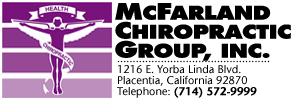|
|
|
<><>MYOFASCIAL RELEASE
Myofascial release is the three-dimensional application of sustained pressure and movement into the fascial system in order to eliminate fascial restrictions and facilitate the emergence of emotional patterns and belief systems that are no longer relevant or are impeding progress. First, an assessment is made by visually analyzing the human frame, followed by the palpation of the tissue texture of various fascial layers. Upon locating an area of fascial tension, gentle pressure is applied in the direction of the restriction. Myofascial release is an effective therapeutic approach in the relief of cervical pain, back pain, fibromyalgia, scoliosis, neurological dysfunction, restriction of motion, chronic pain, and headaches.
<><>MYOFASCIAL TRIGGER POINT THERAPY
Based on the discoveries of Drs. Janet Travell and David Simons in which they found the causal relationship between chronic pain and its source, myofascial trigger point therapy is used to relieve muscular pain and dysfunction through applied pressure to trigger points of referred pain and through stretching exercises. These points are defined as localized areas in which the muscle and connective tissue are highly sensitive to pain when compressed. Pressure on these points can send referred pain to other specific parts of the body.
<><>NEUROMUSCULAR THERAPY
This comprehensive program of soft-tissue manipulation balances the body’s central nervous system with the musculoskeletal system. Based on neurological laws that explain how the central nervous system initiates and maintains pain, the goal is to help relieve the pain and dysfunction by understanding and alleviating the underlying cause. Neuromuscular therapy can help individuals who experience distortion and biomechanical dysfunction, which is often a symptom of a deeper problem. It is also used to locate and release spasms and hypercontraction in the tissue, eliminate trigger points that cause referred pain, rebuild the strength of injured tissues, assist venous and lymphatic flow, and restore postural alignment, proper biomechanics, and flexibility to the tissues.
<><>PRENATAL/PREGNANCY MASSAGE
Performed by a trained perinatal specialist, many methods of massage and somatic therapies are both effective and safe prenatally and during labor and postpartum periods of women’s pregnancies. Prenatally, specific techniques can reduce pregnancy discomforts and concerns and enhance the physiological and emotional well-being of both mother and fetus. Skilled, appropriate touch facilitates labor, shortening labor times and easing pain and anxiety. In the postpartum period, specialized techniques rebalance structure, physiology, and emotions of the new mother and may help her to bond with and care for her infant. Specialized, advanced training in the anatomy, physiology, complications, precautions, and contraindications is highly recommended, and many practitioners require referrals from physicians prior to therapy.
<><>SHIATSU MASSAGE Developed in Japan, shiatsu is a finger-pressure technique utilizing traditional acupuncture points. Similar to acupressure, shiatsu concentrates on unblocking the flow of life energy and restoring balance in the meridians and organs in order to promote self-healing. With the client reclining, the practitioner applies pressure with the finger, thumb, palm, elbow, or knee to specific zones on the skin located along the energy meridians. The treatment brings about a sense of relaxation while stimulating blood and lymphatic flow. The benefits of this treatment may include pain relief and a strengthening of the body’s resistance to disease and disorder.
<><>SPORTS MASSAGE
Sports massage is designed to enhance athletic performance and recovery. There are three contexts in which sports massage can be useful to an athlete: pre-event, post-event, and injury treatment. Pre-event massage is delivered at the performance site, usually with the athlete fully clothed. Fast-paced and stimulating, it helps to establish blood flow and to warm up muscles. During the massage, the athlete generally focuses on visualizing the upcoming event. Post-event massage is also delivered on site, through the clothes. The intent here is to calm the nervous system and begin the process of flushing toxins and waste products out of the body. Post-event massage can reduce recovery time, enabling an athlete to resume training much sooner than rest alone would allow. When an athlete sustains an injury, skillful massage therapy can often speed and improve the quality of healing. SWEDISH MASSAGE One of the most commonly taught and well-known massage techniques, Swedish massage is a vigorous system of treatment designed to energize the body by stimulating circulation. Five basic strokes, all flowing toward the heart, are used to manipulate the soft tissues of the body. The disrobed client is covered by a sheet, with only the area being worked on exposed. Therapists use a combination of kneading, rolling, vibrational, percussive, and tapping movements, with the application of oil, to reduce friction on the skin. The many benefits of Swedish massage may include generalized relaxation, dissolution of scar tissue adhesions, and improved circulation, which may speed healing and reduce swelling from injury.
|
|



